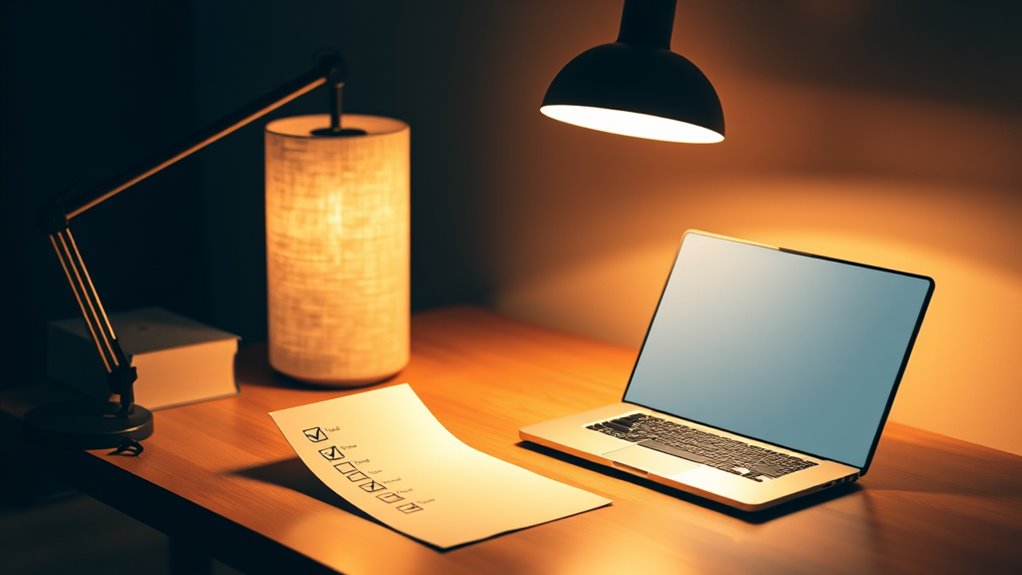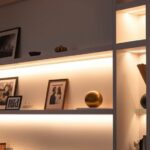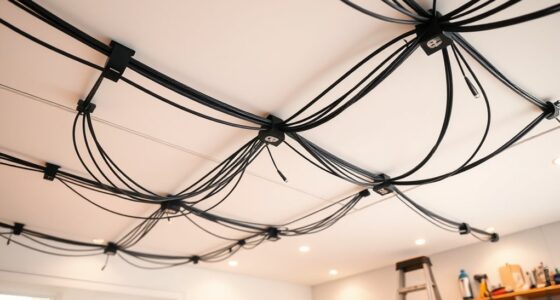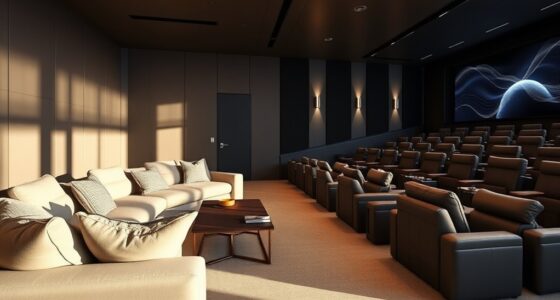To boost your space’s ambiance in just 15 minutes, start by repositioning lamps or adjusting fixture angles to highlight features and soften shadows. Choose warmer tones like 2700K–3000K for coziness or cooler tones for focus, based on your mood goal. Use dimmers or smart controls to tweak brightness easily, layering ambient, task, and accent lighting for depth. Small adjustments like these can transform your environment quickly—stick with us to discover even more simple lighting tweaks.
Key Takeaways
- Reposition lamps or fixtures to highlight key features and diffuse light evenly, creating immediate visual impact.
- Switch to warm (2700K–3000K) bulbs for cozy ambiance or cooler (4000K–5000K) for a more energetic feel.
- Use dimmers or smart controls to quickly adjust brightness levels for desired mood.
- Layer lighting by adding wall sconces or spotlights to create depth and flexibility.
- Make small tweaks like angling fixtures or swapping bulbs to enhance overall atmosphere within 15 minutes.
Optimizing Ambient Lighting in 15 Minutes
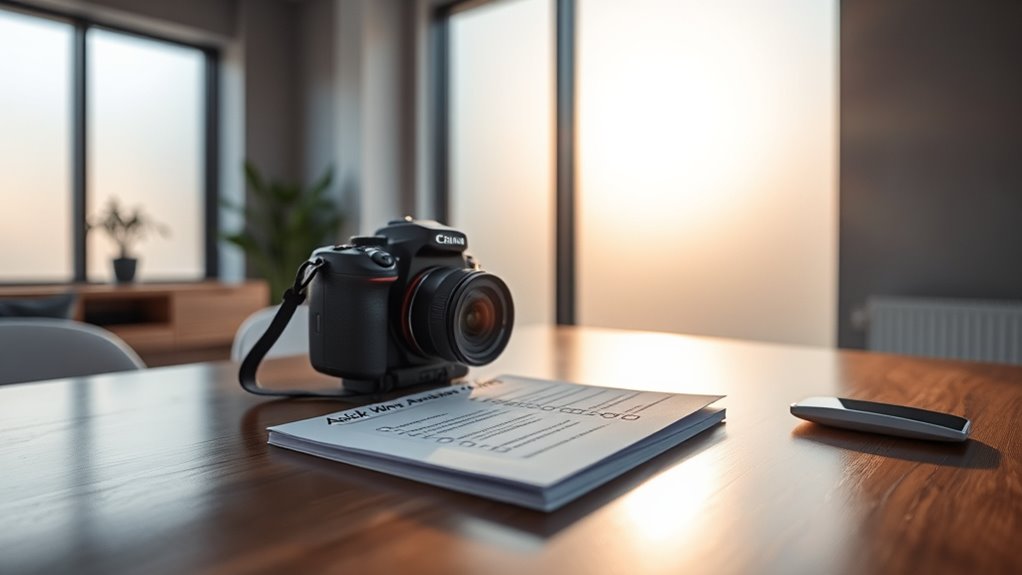
Have you ever considered how ambient lighting can transform a space? It’s often the subtle details that make the biggest difference, and in just 15 minutes, you can tweak your lighting setup to create a warmer, more inviting atmosphere. The key is understanding the importance of lighting placement and color temperature. When you focus on lighting placement, you’re directing attention and setting the mood. Start by evaluating the areas you want to highlight or soften. For example, placing lights near artwork or architectural features draws attention and adds depth, while diffusing light in corners prevents harsh shadows. A simple way to do this quickly is to reposition lamps or adjust the angle of existing fixtures. You don’t need fancy tools—just your eyes and a few minutes to experiment.
Adjust lighting placement to highlight features and soften shadows effortlessly.
Next, consider color temperature, which influences how warm or cool a space feels. If your goal is coziness and relaxation, aim for warmer tones around 2700K to 3000K. These lights mimic sunset hues and create a comforting ambiance. On the other hand, if you want a more energetic or focused environment, cooler temperatures around 4000K to 5000K work better, mimicking daylight and boosting alertness. Adjust your bulbs or switch to smart lighting options that allow you to change color temperature on the fly. Making small shifts between warm and cool tones can greatly alter the mood without requiring a complete overhaul.
In your quick lighting upgrade, don’t overlook the placement of light sources relative to your space. For instance, placing a lamp behind a seating area can cast a gentle glow that reduces shadows and softens the room. Alternatively, installing wall sconces or directional spotlights can add layers of light, making the space feel more dynamic and inviting. Be mindful of glare or overly bright spots, which can feel harsh or uncomfortable. Use dimmers if you can, so you have more control over brightness levels. Additionally, understanding resources and tools available for lighting design can help you achieve optimal results faster, whether through apps or hardware adjustments. Moreover, exploring lighting layering techniques can create a more sophisticated and comfortable environment. Incorporating knowledge about lighting placement is essential to getting the most out of your lighting adjustments efficiently. Recognizing how emotional support can be enhanced through ambient lighting helps you create spaces that promote relaxation and well-being.
Furthermore, selecting ambient light strategies that suit your specific space can enhance the overall effect. In just a few minutes, you can reposition fixtures, swap bulbs, or adjust settings to improve your room’s ambiance. Think about the overall vibe you want to achieve—whether it’s cozy, energizing, or somewhere in between—and align your lighting placement and color temperature accordingly. Small, deliberate changes can make a noticeable difference, helping you craft a space that feels just right, fast and effortlessly.
Frequently Asked Questions
Can Ambient Light Strategies Improve Energy Efficiency?
Yes, ambient light strategies can boost your energy efficiency. By adjusting color temperature, you can create a comfortable environment that reduces the need for artificial lighting. Incorporating natural light further minimizes energy consumption, as sunlight naturally illuminates your space during the day. You’ll save on electricity costs and enhance your space’s ambiance, all while making smarter lighting choices that benefit both your wallet and the environment.
What Tools Are Needed for Quick Ambient Lighting Assessments?
Did you know that using lighting sensors can cut energy use by up to 30%? To perform quick ambient lighting assessments, you’ll need basic tools like a light meter to measure current light levels and a checklist for evaluating existing systems. Dimming controls are also essential, allowing you to optimize lighting based on sensor data. These simple tools help you identify opportunities for immediate energy savings efficiently.
How Often Should Ambient Lighting Be Reevaluated?
You should reevaluate your ambient lighting at least once a year to guarantee it meets lighting standards and continues to support your space’s needs. Regularly reviewing your lighting ensures it aligns with current standards and maintenance schedules, preventing issues like dimming or glare. If your environment undergoes significant changes or new standards emerge, consider more frequent assessments. Staying proactive helps maintain ideal lighting conditions and enhances overall safety and comfort.
Are There Safety Concerns With Rapid Lighting Adjustments?
Safety concerns with rapid lighting adjustments can arise if safety protocols aren’t followed. You should guarantee emergency lighting remains functional and unaffected, as sudden changes might cause confusion or accidents. Always prioritize clear communication and proper maintenance, so you prevent potential pitfalls. By adhering to safety protocols and regularly inspecting emergency lighting, you can confidently manage lighting tweaks without risking safety or creating hazards.
Can Ambient Lighting Impact Productivity or Mood?
Ambient lighting considerably impacts your productivity and mood by influencing how you feel and work. When you choose the right color temperature, like cooler tones for focus or warmer for relaxation, you enhance your environment. Additionally, glare reduction minimizes eye strain, helping you stay comfortable and alert. Proper lighting creates a positive atmosphere, boosts motivation, and keeps you engaged, ultimately improving overall performance and well-being throughout your day.
Conclusion
Think of your space as a canvas, and ambient lighting as the brushstrokes that bring it to life. With just 15 minutes, you can transform your environment into a welcoming masterpiece. By quickly implementing these strategies, you’re not just adding light—you’re setting the mood, enhancing comfort, and making every moment in your space more inviting. Don’t wait for perfection—start painting your perfect ambiance today, one simple step at a time.
